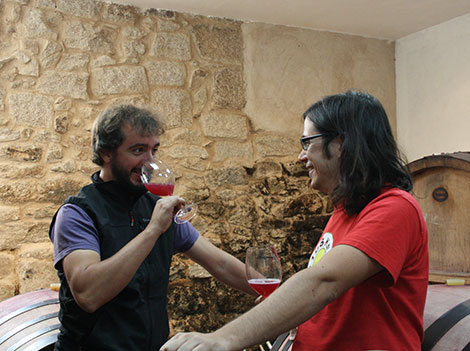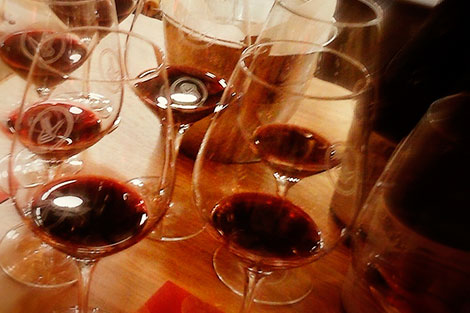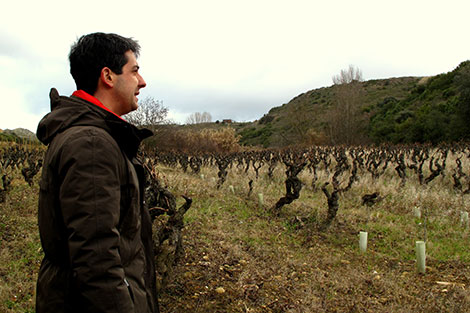
Named after a popular cartoon series broadcast on Spanish TV in the late 1970s and early 1980s, Comando G (Battle of the Planets, for US and UK viewers) was created by Daniel Gómez Jiménez-Landi —aka Daniel Landi—, Fernando García Alonso and Marc Isart, who met while studying Winegrowing and Oenology at Madrid’s Polytechnic University. Given that their project focused on the Gredos region and Garnacha, the letter G fitted in perfectly.
On a mission to save Gredos
While the five youths in the series had to protect Earth from alien attacks, these Garnachistas are proud to have rescued the mountain vineyards and wines of Gredos from obscurity, to the point that they now rub shoulders with Spain’s top reds. They have recovered some fascinating, endangered plots, often perched on impossible places —have a look at the pictures above— and have brought social and economic advancement to the area.
Less than an hour’s drive from Madrid, Gredos increasingly resembles a budding Priorat, where small ventures, a terroir-based approach and commitment to quality are standard values. Comando G is the epitome of this spirit and exemplifies the local winemakers’ profile: a young bunch of relaxed and enthusiastic people fascinated by the mountainous landscape.
The area is a real jigsaw of provinces (Madrid, Ávila and Toledo), autonomous regions (Madrid, Castilla y León and Castilla-La Mancha) and appellations: DO Vinos de Madrid, DO Méntrida (Toledo) and a third one for Ávila’s vineyards rumoured to be on the pipeline —if it goes ahead, it would mean the replacement of the current VT Castilla y León indication for DO Cebreros.
Those working in the area, however, would like to see a single geographical identity for the whole Sierra. Native and perfectly adapted Garnacha is the dominant grape with soils (granite with some schist areas in Cebreros and El Tiemblo) providing a distinctive minerality to the wines. Combined with a Burgundian approach, the region’s wines are distinctive and seemingly light bodied but with such grip, length and expression that they clearly stand out.
Landi thoroughly described the region, its valleys and villages, as well as the aims of the recently founded Garnachas de Gredos Association in an article published last year in Elmundovino (in Spanish), in which he even proposed a new appellation for the area. With a degree in Philosophy, he seems to be the ideologue behind this Garnacha movement.
Commando Garnacha
Family issues and time constraints forced Marc Isart, winemaker at Bernabeleva in San Martín de Valdeiglesias (Madrid), to leave Comando G. Current partners are Daniel, 38, who worked his last vintage at Jiménez-Landi in 2011 to embark on his personal adventure; and Fernando García, who works as winemaker for Bodega Marañones in San Martín de Valdeiglesias (Madrid).
“At the start, I had no idea about wine”, acknowledges Landi. Along with his cousin, they relaunched the family winery in DO Méntrida in 2004. Two years later, he discovered El Real de San Vicente, the last village in the appellation and the only one within the boundaries of Gredos.
Fernando, 36, studied Agronomy in Madrid and specialized in Phytoscience but just 15 days into harvesting with well-known winemaker Raúl Pérez in Bierzo in 2004 were enough for him to fall in love with winegrowing. In December of that year he started to work for wine retailer Lavinia in Madrid: “Back then, with up to 4,500 labels and a wide range of organic and biodynamic labels, it was a great school for me. I used to spend all my money on wine," he recalls.
In 2006 he got a job at Telmo Rodríguez’s multi-regional project. "I learned an awful lot from him," he says. A respected producer, Rodríguez is the co-owner of a company which makes wine in 9 different Spanish wine regions. The list includes Cebreros, where Telmo has been producing a red Garnacha called Pegaso together with rally drive Carlos Sainz since the late 1990s. Fernando García recalls spending all of his free time visiting wineries in France: Burgundy, Loire, Rhone... “I was particularly obsessed by the fact that Spanish wines lacked a mineral character,” he points out.
The antithesis of Tempranillo
For his part, Daniel travelled and learned as much as he could between 2004 and 2007. To his mind, the most important thing is “to have a clear idea about the type of wine you want to make, so that you can create your own style based on what is feasible in your region.” He concludes that “any project must be sustained by concepts.”
His concepts include seeking fresh, elegant, mineral wines. Fernando adds: “We are only making wine here and that’s because we want to see how far we can go with Garnacha in this terroir”. For that, they have embarked on an in-depth study of the area: valleys, soils, villages and the location of historic vineyards. They are particularly obsessed with one idea: reflecting “the landscape” in their wines.
While Daniel Landi’s wines come from El Real de San Vicente (Toledo) with just two separate plots in El Tiemblo and Cebreros (Ávila), 15 out of the 20 hectares currently managed by Comando G are located in Rozas de Puerto Real (Madrid) with a few plots in the Alto Alberche Valley in Ávila. Most of the time, official boundaries don’t seem to match geographic natural borders in Gredos as both El Real and Rozas stand in the Tiétar Valley and share a similar green landscape due to high rainfall levels.
Freshness benefits from these climatic conditions as well as from high altitude and northern and eastern exposures. Vineyards are grown accordingly: “We do it exactly the opposite as is the case with Tempranillo,” explains Daniel Landi. Leaving aside concentration and trying to extend the time on the vine are key issues. In this way (and with yields usually working well at around 3,000-4,000 kilos per hectare), bunches manage to ripe slowly and the fruit gains complexity. Vineyards are grown organically while the most distinctive plots destined to single-vineyard wines are farmed with biodynamic. “Biodynamic really works”, says Landi telling from a devastating hailstorm that stroke Las Umbrias vineyard in July 2012; thanks to a preparation of nettle that they applied every week the plants recovered themselves to the point of growing leaves and ripening grapes.
“This is not about numbers but feelings and perceptions,” continues Landi who introduces the idea of ‘savoury maturation’. Prior to harvest, they monitor each vineyard at the same time of the day to make sure when grapes ‘taste’ in such a way that they can be picked; even if analytic data, which it is not always performed, might not support their decision.
Both Comando G’s (expected to reach roughly 75,000 bottles in the coming years) and Daniel Landi’s wines (around 15,000 bottles from 7 hectares) are made at a small winery located in Cadalso de los Vidrios. Up to 45 separate fermentations take place each harvest in all kind of vessels: wooden vats, small plastic vats or open barrels. Grapes are rarely destemmed in order to achieve more freshness, so whole bunches go directly into de vats where they are trodden softly ("only up the ankles and just during the first days of maceration"). Pumping and pigeage are part of the past; high technology to soak the hat is limited to a simple watering can (see Daniel Landi’s demo on the image above). In contrast, maceration times are particularly long: from a minimum 30 days in the entry-level label La Bruja which focuses mainly on fruit to up to 70 days when it comes to single-vineyard wines. According to Daniel Landi, it takes much longer to bring out both the landscape character and minerality. No wonder the wines have to be protected with carbon dioxide in the latest stages of this slow process.
After pressing, the wines age in barrels, vats or foudres in a slightly reductive atmosphere. Big formats are definitely preferred in order to keep Grenache vivid aromas. Single-vineyard wines usually have their own vat or foudre. Regarding sulphur dioxide, small quantities are added to harvested grapes and wines after malolactic fermentation and prior to bottling totalling about 40-50 grs./litre. Although Comando G cannot be considered a natural producer, Landi supports the movement “providing the winemaking style doesn’t mask the landscape”.
Witches, graves and drums
Fun, fruity and juicy La Bruja Avería (€12.60 at Vinissimus) is Comando G’s flagship label. Production has risen to 40,000 bottles for the 2014 vintage and the goal is to reach 60,000 bottles annual production. The name comes from a cult children’s TV programme from the 1980s and according to the winery’s Burgundian approach it should be considered their village wine attempting to show Rozas de Puerto Real’s distinctive landscape. With up to 40% grapes still sourced from local winegrowers, most vineyards come from the lower part of the U-shaped valley between the townships of Rozas, Cadalso and Cenicientos. According to Daniel Landi, vines closer to Cadalso show well-balanced red fruit while the style gets fresher and finer towards Rozas.
Released just a few weeks ago, the new Rozas 1er Cru 2013 (below 5,000 bottles but aiming to reach 10,000 in the future, €26.90 at Lavinia or via Wine Searcher) blatantly continues to apply the Burgundian hierarchy to the area. This Grenache comes from vineyards located in the foothills of the mountain and therefore at a higher altitude (900 metres). It’s a nice example of what to expect from Gredos’ cooler areas: citrus and wild fruits aromas, followed by juiciness, depth and minerality on the palate. The 2014 vintage I tasted from barrel showed amazing expression.
The top of the range shows both climbing prices and altitude. It encompasses different single-vineyard wines made in tiny quantities and more suitable I would say for terroir-obsessed wine lovers. Las Umbrías (between 600 and 2,000 depending on harvest conditions, €59.90 at Lavinia or via Wine Searcher) was the first wine ever produced by Comando G in the 2008 vintage. This is a half-hectare plot with over 60-year old vines located at the top of the so called Roe Deer Mountain. Practically abandoned when Comando G acquired it, it was recovered based on biodynamic practices. Daniel highlights the characteristic breeze in the setting. “The wind influences the fragrance of a wine and helps to set the aroma”, he says.
There are still three other cru-like wines coming from a completely different area, the Alto Alberche valley in the province of Ávila (Castilla y León) where some of Gredos’ highest plots can be found. Both Rumbo al Norte and Tumba del Rey Moro are particularly extreme. The former is a less than half-hectare, northeastern exposure, 1,150 metres high vineyard located in Navarrevisca with 55-year old vines growing among large rocks. Vines grow so close that not even a horse can enter in some areas to farm the land; yields hardly reach 1,500 kilos per hectare and harvest takes place at the end of October. Most vineyards have been uprooted in this area. Rumbo al Norte (about 1,000 botellas, €90.50 at Lavinia or via Wine Searcher) reflects naturally these facts; it’s sharp and Atlantic in style with green peppery nuances and a rather extreme yet fascinating cool minerality on the finished linked to granitic soils.
Across the valley, in Navatalgordo, you can spot an even higher (1,230 metres) vineyard which grapes reach ripeness even later. El Tamboril (above €50 via Wine Searcher) is the little craziness from where Comand G sources grapes for an original white which skips the dominant Albillo-pattern and uses White and Grey Grenache instead. More recently they are experimenting with a Jura-inspired white aged under a flor veil in demijohns. In fact they have bottled about 100 50 cl. bottles and some magnums of the so called Tamboril Crianza Biológica which must be seen more as an amusement than a ‘real” wine.
Back to Grenache and heading East, Tumba del Rey Moro (€58.90 at Vinissimus or via Wine Searcher) is a wild, pre-phylloxera vineyard located in Villanueva de Ávila. In fact, when I visited it with Fernando García I could hardly believe that they could obtain any grapes from such a chaotic, almost vertical setting that spread downhill with vines surrounded by oak trees, chestnuts and fig trees. “This is pure North; a shady and cool vine”, he said. To my mind, probably, Comando G’s Grenache with the longest finish.
Daniel and Fernando have just revamped Comando G’s packaging (see some shots above) and the focus is definitely on the back labels where they state their particular definition of the territory following the Burgundian pattern: valleys, villages, crus if it is the case and the general Sierra de Gredos indication. The ‘official’, much smaller label on the contrary shows the established appellations DO Vinos de Madrid in their Rozas de Puerto Real’s labels and VT Castilla y León in those coming from Ávila. Note also a couple of lines in a poetic tone like those shown on El Tamboril label: “Grey and White Grenache assembled in granitic rock rifts. Deep narrowness profiles, the metaphysics of touch, banned chords from the mountains (sic)”. I guess many would rather drink the wine but the truth is that everything, the concepts, the wines and the work behind the scenes, look very consistent nowadays. Less casual or heroic than in the past perhaps, but aren’t Fernando and Daniel maturing as their wines?

Amaya Cervera
A wine journalist with almost 30 years' experience, she is the founder of the award-winning Spanish Wine Lover website. In 2023, she won the National Gastronomy Award for Gastronomic Communication
NEWSLETTER
Join our community of Spanish wine lovers






